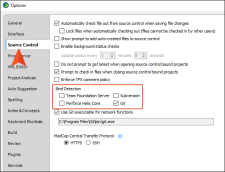Flare has options for bind detection, disabling providers, and unbinding providers. Although these are separate features, they are all somewhat related. This information is especially important if you are using an external tool to bind and manage your source control tasks.
[Menu Proxy — Headings — Online — Depth3 ]
Bind Detection
Flare's bind detection settings are found on the Source Control tab of the Options dialog.
Bind detection scans your project when you load it to see if the project has been previously bound to source control. If a binding is detected, you then have the option of applying the binding and committing the project to source control. Depending on the provider you are using, Flare may search the file system and its artifacts, as well as contact and query servers, to find potential source control bindings.
When you open a Flare project that hasn't been bound to source control before, the bind detection option is disabled for Perforce Helix Core, Subversion, and Team Foundation Server. It is enabled by default for Git
Note You can use bind detection as an alternative to importing a Flare project. If you have received a Flare project file (e.g., by copying it from a server, by opening it from a network location), you can simply open the file and Flare will search for and apply existing source control bindings.
Note Source control providers are scanned in the following order:
- Git
- Subversion
-
Perforce Helix Core
Tip Detecting source control bindings may take a considerable amount of time. It is recommended that you select only the source control providers that you use to speed up the detection process.
Disabling Providers
By default, when a project is bound to source control, the provider (Git, Perforce Helix Core, Subversion, or Team Foundation Server) is enabled. This means that the source control interface elements in Flare are visible, and you can use them to perform various tasks (e.g., commits, synchronize changes).
Disabling a provider means that the source control interface elements are no longer shown. This does not mean you cannot use source control. As long as the provider is still bound to the project, you can perform source control tasks in a third-party tool outside of Flare.
For more details and steps, see Disabling a Team Foundation Server Provider.
Unbinding Providers
When you unbind a provider, it means you are removing the connection altogether between the Flare project and the local repository.
You can unbind a provider via the Project Properties dialog or the Settings view in the Source Control Explorer. Click the Unbind Provider button.
For more details and steps, See Unbinding a Team Foundation Server Provider.


